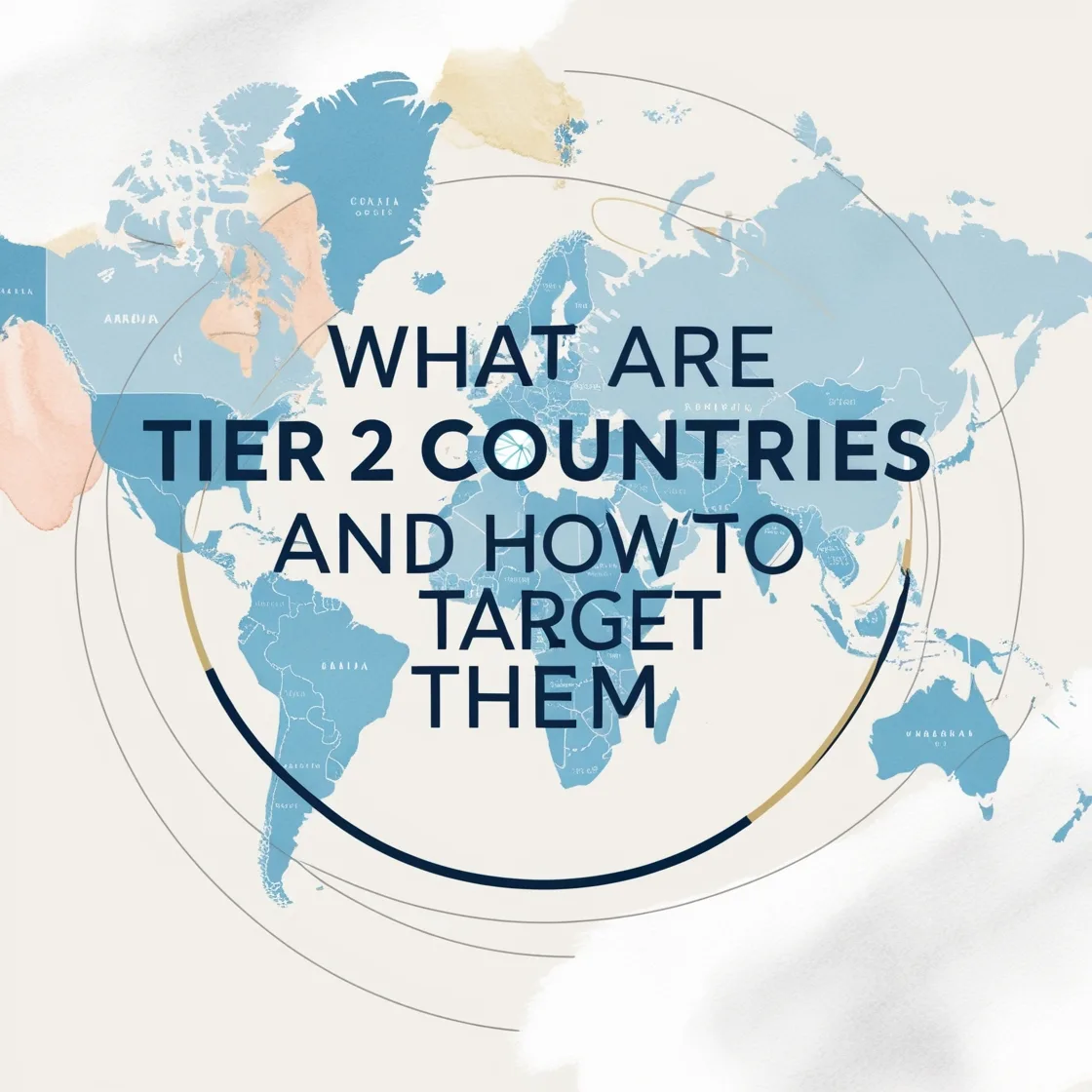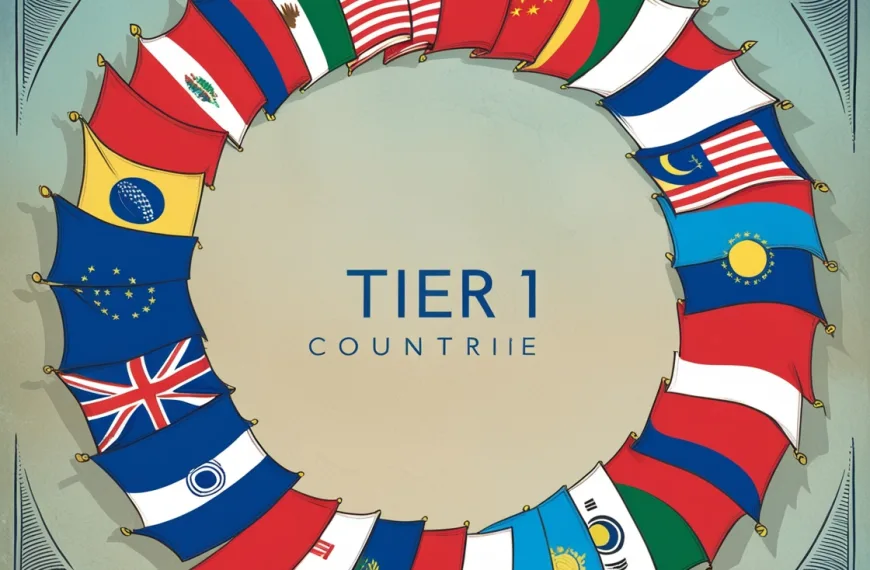Tier 2 countries are places where economies are growing quickly, the middle class is expanding, more people are using the internet, and consumer spending is rising. For companies wanting to grow outside the busy Tier 1 markets, Tier 2 countries provide good opportunities. Let’s explore what Tier 2 countries are like, how they differ from Tier 1, and why businesses should pay attention to them.
When dealing with international marketing, it’s crucial to understand how to group markets effectively. One popular way to organize global markets is through the tier system, which categorizes countries into Tier 1, Tier 2, and Tier 3. This classification considers factors like economic development, purchasing power, and infrastructure. Tier 1 countries have often been the main focus. But now, Tier 2 countries are playing a bigger role in the world economy, which is something we can’t overlook.
Definition of Tier 2 Countries
Tier 2 economies are countries that are in the middle of the development scale. They are not as advanced or wealthy as the world’s most developed nations, but they are more economically and structurally developed than the least developed countries. These economies show moderate levels of growth in their industries and infrastructure, which means they are progressing and improving but have not yet reached the high standards seen in the most developed nations. They may not be as attractive as Tier 1, still they have:
- Strong economic growth.
- An increasing urban population.
- Improved technological infrastructure.
- Higher disposable incomes.
- A rising middle class skilled in technology.
These nations are sometimes called emerging markets or developing economies. Although challenges like government regulations or infrastructure issues exist, they offer special chances for businesses that can adjust their strategies.
Examples of Tier 2 Countries
There isn’t a fixed list of Tier 2 countries, as it can change based on industry or market context. However, some well-known Tier 2 countries are:
- India. With a large population and a fast-growing digital environment, India is a key Tier 2 market.
- China (excluding major cities like Beijing and Shanghai). While these big cities are Tier 1, other parts of China are Tier 2.
- Brazil. As the largest economy in Latin America, it provides a robust consumer base and a rapidly growing e-commerce market.
- Mexico. Strong trade links with the U.S. and a growing middle class transform Mexico into an attractive Tier 2 market.
- Indonesia. The leading economy in Southeast Asia, driven by a youthful demographic and growing internet usage.
- Turkey, Vietnam, South Africa, Philippines, Colombia. Other Tier 2 markets with great growth potential.
Features and Challenges of Tier 2 Markets
Tier 2 markets have specific traits and difficulties that make them stand out from Tier 1 and Tier 3 markets. Understanding these is crucial for creating successful Tier 2 countries marketing strategies.
| Features | Description |
| Rising Digital Adoption | In Tier 2 countries, internet and mobile usage are rapidly increasing. Social media, mobile apps, and digital payment solutions are popular, opening new opportunities for digital marketing and e-commerce. |
| Price Sensitivity | Consumers in Tier 2 markets are often more focused on price than those in Tier 1. They want value for money, so businesses need to find a balance between affordability and quality. |
| Cultural Nuances | Tier 2 markets are culturally diverse. Localized content works better, so successful businesses familiarize themselves with local languages, customs, and values to connect with their audiences. |
| Urbanization and Infrastructure Development | Many Tier 2 developing countries are experiencing rapid urban growth. As cities expand and infrastructure improves, access to goods, services, and digital technologies increases. |
| Regulatory Environments | Although many Tier 2 countries are welcoming international business, navigating their regulations can be challenging. Rules on imports, data privacy, and advertising differ widely and require careful attention. |
Nowadays targeting Tier 2 countries presents not also many opportunities but challenges as well. The key challenge is the diversity and complexity of these markets. With a wide range of cultures, languages, and preferences, applying the same strategies across all Tier 2 countries can be difficult. Companies must invest in detailed market research and create tailored campaigns to effectively reach their target audiences. Another major challenge is dealing with complex local rules. While Tier 2 countries are more open to global business, their regulatory environments can be unpredictable.
Companies operating in Tier 2 markets face several challenges. They must deal with trade restrictions, advertising rules, data privacy laws, and changing currency policies. Local expertise and a flexible compliance plan are vital to handle these legal issues effectively. Price sensitivity is another critical aspect. Consumers in these markets are usually cautious with their spending and seek products that offer good value for the money. Businesses need to price their products smartly, balancing affordability and quality to stay competitive and provide real value. Infrastructure issues can also pose obstacles. Even though many Tier 2 countries are developing quickly, there are still gaps, especially outside major cities. Problems like poor transportation, unreliable internet, and outdated digital payment systems can affect logistics, customer service, and overall business efficiency. Building brand awareness and trust takes time in these markets. International companies may have to compete with established local brands or face consumer scepticism about new products. Gaining a loyal customer base requires consistent engagement, a strong local presence, and an understanding of local cultural values. In summary, while Tier 2 countries offer great growth opportunities, success hinges on a company’s ability to manage cultural diversity, navigate regulatory challenges, meet pricing expectations, overcome infrastructure issues, and focus on long-term brand building.
Why It’s Important to Focus on Tier 2 Countries
Focusing on Tier 2 countries is becoming crucial for businesses aiming for growth and smart expansion. Tier 1 countries are often crowded with businesses and competition, but Tier 2 markets offer untapped potential with large, fast-growing consumer groups. Companies that enter these markets early can establish strong brand awareness and secure long-term customer loyalty. A major factor driving this opportunity is the rise of the middle class. As economies improve in many Tier 2 nations, millions of people are gaining more spending power. This growing segment is creating demand for various consumer products, digital services, and lifestyle goods, offering businesses excellent chances to grow.
Marketing in Tier 2 countries is usually less expensive. Costs for advertising and acquiring new customers are generally lower compared to Tier 1 markets, allowing brands to reach and connect with many consumers even with smaller budgets. Digital marketing and influencer campaigns are particularly effective here. Innovation is not just happening in big markets; Tier 2 markets are also places where new ideas and developments are growing strongly. These mid-income countries often skip traditional development stages and quickly adopt new technologies and business models. This environment offers brands the chance to introduce new solutions and adapt to local needs in creative ways.
Expanding into Tier 2 countries also supports strategic diversification. It lessens reliance on established markets and reduces risks tied to economic changes in Tier 1 areas. Building a presence in Tier 2 countries positions brands to handle global shifts better and benefit from the next wave of economic growth.
Strategies for Successfully Targeting Tier 2 Markets
To succeed in Tier 2 countries, businesses should focus on local needs, staying flexible, and offering good value. Here are the main strategies:
1. Understand the Market
Get to know your customers well. Study their age groups, buying habits, cultural interests, and current market trends. This information is essential for achieving success.
2. Localize Your Products
Adjust your products and services to fit local needs. Change the language, set prices that people are willing to pay, offer payment methods they use and provide reliable customer support.
3. Use Digital Tools
Social media, mobile apps, and e-commerce platforms are essential in Tier 2 markets. Make sure your digital marketing matches local tastes and keeps up with what’s popular.
4. Collaborate with Locals
Partner with popular local figures, distributors, or retailers. This helps to build credibility and makes it easier to enter the market.
5. Highlight Value
Showcase how your products offer good quality at a fair price. Emphasize how they make life easier or solve local problems.
6. Stay Flexible
These markets can change quickly, so be ready to adapt your plans based on feedback and new developments.
7. Build Trust and Recognition
Focus on establishing a trusted brand. Gaining the trust of consumers is crucial, particularly when introducing an unfamiliar or foreign brand in a new market. A wise investment in creating and strengthening a brand over many years is expected to bring significant advantages and increased value. Building a brand thoughtfully and strategically ensures that its benefits and impact grow over time, leading to long-lasting success and recognition in the market. Conclusion
Tier 2 countries are positioned to be major contributors to the world’s future economic expansion. As their economies expand and people start spending more, they become attractive spots for businesses aiming to grow globally. While there are obstacles, the potential benefits for brands that learn and adjust to local cultures can be huge. To succeed in Tier 2 countries, businesses should thoroughly research and understand the local culture. By focusing on offering good value and adapting to local needs, marketers can tap into great opportunities and establish a strong presence as these nations become more influential in the global economy.








